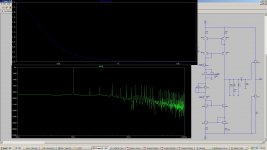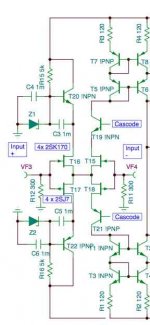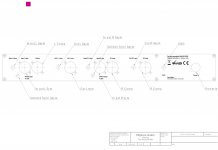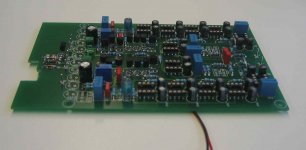Sure Frans. On the other hand i plan a meeting of us and then you can listen to my system. I think it is up to the task of differentiating phono stages.
That would be cool
...
There is only one place where the sound is/was like original, and that place is at the start of the chain. There is only one place like home, and that is at the end of the chain. Whatever you do in between it will change the sound, ....
Frans, you put it in very good words. This being said, I still would like to have as much of the sound that went into the chain (especiallythe microdetails) coming out at the end of the chain. One thing R2 does very well in my opinion is preserving information, thats the basis for my comments....
We called it transparency in the old days. Problem is that this sometimes comes with the system sounding sterile. What i am searching for is transparency but coupled with a sound that fits together. Call it musicality.
The task is not simply input=output. Then a single stage RIAA with NE5534 would do the job with MM cartridges. That would make this whole thread obsolete.
One problem is that what is on the record is only a blue print in the best cases.
It is like making a marmalade out of fresh fruits. Even with the greatest care it will never taste the same.
BUT, there are some exceptional recording like "Bellafonte at Carnegie Hall " that can give the illusion of being there. And when my system improves i can hear new things that i have not realized before. The problem then is : has this information being there before and have i simply overlooked it in the first place.
The task is not simply input=output. Then a single stage RIAA with NE5534 would do the job with MM cartridges. That would make this whole thread obsolete.
One problem is that what is on the record is only a blue print in the best cases.
It is like making a marmalade out of fresh fruits. Even with the greatest care it will never taste the same.
BUT, there are some exceptional recording like "Bellafonte at Carnegie Hall " that can give the illusion of being there. And when my system improves i can hear new things that i have not realized before. The problem then is : has this information being there before and have i simply overlooked it in the first place.
I tried to simulate the starless circuit using LTSpice.
In attachment my simlation results with THD Vs. Frequency and FFT 1mV at 1KHz input.
It looks to me like something is not right with my results at least.
I will try to breadboard the circuit shortly and make measurements on it.
Meanwhile if anybody here has some tips as for why my simulation looks odd please let me know.
Thanks.
In attachment my simlation results with THD Vs. Frequency and FFT 1mV at 1KHz input.
It looks to me like something is not right with my results at least.
I will try to breadboard the circuit shortly and make measurements on it.
Meanwhile if anybody here has some tips as for why my simulation looks odd please let me know.
Thanks.
Attachments
An input like this is balanced symmetric at the input and transforms to unbalanced.
I would build the mirror, RIAA and buffer the same as in the Paradise R2. That has proven to work best and is unproblematic. I would cascode the J-Fets for lower distortion and lower input capacitance. Maybe MiiB has another opinion and we do not cascode the Fets.
Then it is really a Paradise R2 with balanced JFet input. We could even use the existing PCBs with some modification.
I would build the mirror, RIAA and buffer the same as in the Paradise R2. That has proven to work best and is unproblematic. I would cascode the J-Fets for lower distortion and lower input capacitance. Maybe MiiB has another opinion and we do not cascode the Fets.
Then it is really a Paradise R2 with balanced JFet input. We could even use the existing PCBs with some modification.
Attachments
wouldn't that be a balance to SE stage?
I just think it would be pretty cool to have a fully balanced phono stage that can mate good with a full balance audio system.
Although I have my concern on using the balance on the phono section due to the non-balance nature of the cartridge signal.
Am I wrong? The signal can be made balance by a divider to ground and using plus and minus as the hot and cold.
But isn't the true balanced 180deg out of phase?
Just wondering, becuase if from one side having a fully balanced seems so cool, if there are not true bases for a real balanced signal then it is kind of a waste of circuitry.
I would love to have your opinion guys.
I just think it would be pretty cool to have a fully balanced phono stage that can mate good with a full balance audio system.
Although I have my concern on using the balance on the phono section due to the non-balance nature of the cartridge signal.
Am I wrong? The signal can be made balance by a divider to ground and using plus and minus as the hot and cold.
But isn't the true balanced 180deg out of phase?
Just wondering, becuase if from one side having a fully balanced seems so cool, if there are not true bases for a real balanced signal then it is kind of a waste of circuitry.
I would love to have your opinion guys.
OK, this is the circuit with the negative side as constant current source. We decided not to use it because only one side is amplifying.
What we could do is a Paradise R2 but with JFets at the input arranged symmetric.
that would be wonderful, having a Jfet input stage would sound really interesting also for the extremely low input DC offset which is probably a little preferable for an MC phono stage.
I will definitely build this as well.
At the moment I am working on my little design 3 stages passive RIAA No Global Feedback,battery powered with shunt regulators and sub-regulators trying to get output noise to an acceptable level.
I have been struggling a little bit with that due to the compleity of the board (I had to design a 4 layer board to optimize the ground plane but maybe that was an overkill).
Anyway I Can't wait for the Paradise R2.
If it can be of any help and I would really enjoy it at the same time, I can do audio and lab measurement testing on the beta version if you guys decide to include me on that.
I have a really remarkable audio chain and good ears as well and I could offer my two cents on the sound and on the functionality of the board.
Let me know if you guys want to hire me in
Stefano, a balanced input can make sense with a phono stage. You are right : a cartridge is not balanced but what i call floating. Balanced would mean that the cartridge had two windings per channel out of phase and the middle referenced to ground.
So why can balanced have an advantage ? It is hum pickup. In a well build table this is not a problem. Even with an unbalanced input hum can be very low. On the other hand there are turntables where the arm is not shielded for example, or where is noise ingress from the motor. Under this conditions a balanced input can help to suppress the hum. One disadvantage though is that a balanced stage has 3dB more noise when the same amount of input devices are used. Say we use 4 x 2SK170 plus 4 x 2SJ74.
The unbalanced stage will have 0.3nV/qHz noise and the balanced will have 0.45nV/qHz noise. That is still 6dB better then an AD797 but using Fets there is some 1/F noise under 1kHz.
Making a fully balanced in, balanced out stage is something else all together.
So why can balanced have an advantage ? It is hum pickup. In a well build table this is not a problem. Even with an unbalanced input hum can be very low. On the other hand there are turntables where the arm is not shielded for example, or where is noise ingress from the motor. Under this conditions a balanced input can help to suppress the hum. One disadvantage though is that a balanced stage has 3dB more noise when the same amount of input devices are used. Say we use 4 x 2SK170 plus 4 x 2SJ74.
The unbalanced stage will have 0.3nV/qHz noise and the balanced will have 0.45nV/qHz noise. That is still 6dB better then an AD797 but using Fets there is some 1/F noise under 1kHz.
Making a fully balanced in, balanced out stage is something else all together.
I make a commercial stage, the Suesskind Rauschfrei, that is totally balanced, in to out.
It also has unbal in - unbal out, bal in - unbal - out and unbal in - bal out.
It has a lot of discrete components in the input ( Jfets and BJts), and the PSU plus 32 opamps, 2 fully balanced opamps, two bal-unbal converters and 8 !!! servos.
AHH yes, there are two opamps in the PSU too.
I can really not imagine that this can be build DIY unless you are a professional.
It also has unbal in - unbal out, bal in - unbal - out and unbal in - bal out.
It has a lot of discrete components in the input ( Jfets and BJts), and the PSU plus 32 opamps, 2 fully balanced opamps, two bal-unbal converters and 8 !!! servos.
AHH yes, there are two opamps in the PSU too.
I can really not imagine that this can be build DIY unless you are a professional.
There's newer overkill when it comes to grounding....I believe that understanding grounding is as important is as important as to understanding the circuit.
I fully agree with you. GND is very important in order to max out performance of a circuit.
Unfortunately 4 Layers is more expensive and most of all, if you want to have a special dielectric like Teflon it is very hard to obtain.
I make a commercial stage, the Suesskind Rauschfrei, that is totally balanced, in to out.
It also has unbal in - unbal out, bal in - unbal - out and unbal in - bal out.
It has a lot of discrete components in the input ( Jfets and BJts), and the PSU plus 32 opamps, 2 fully balanced opamps, two bal-unbal converters and 8 !!! servos.
AHH yes, there are two opamps in the PSU too.
I can really not imagine that this can be build DIY unless you are a professional.
I could

I was looking for pics of the inside, but I couldn't find them on the web.
What do you think of a fully balance stage vs. a SE from a sonical standpoint?
Problem is that even i have not heard ( maybe by coincidence but i do now know ) a complete chain from cartridge to loudspeaker. That would be exiting. Theroretically it should be very free of noise and common mode distortion. Also second harmonic is suppressed ( do we want that ? ) and noise from the PSU is suppressed in the power amps when they are bridged.
Problem is that even i have not heard ( maybe by coincidence but i do now know ) a complete chain from cartridge to loudspeaker. That would be exiting. Theroretically it should be very free of noise and common mode distortion. Also second harmonic is suppressed ( do we want that ? ) and noise from the PSU is suppressed in the power amps when they are bridged.
I have a balance preamplifier and a balance power amplifier with all balance cables but I have never had a balance phono stage so I have never hat the pleasure to try the all combination either.
I can say that connecting the electronics in balance mode vs SE in my case made a significant improvement for what it matters even having a SE PH.



